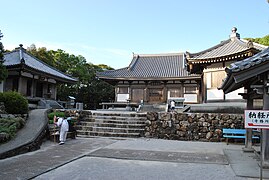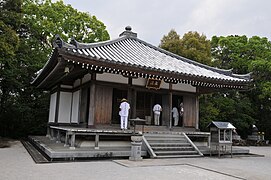Dainichi-ji (Kōnan)
The Dainichi-ji ( Japanese 大 日 寺 ), with the Go Hōkaisan (法界 山) and Kōshōin (高 照 院) in the city of Kōnan ( Kōchi Prefecture ), is a temple of Shingon Buddhism . In the traditional count it is the 28th temple on the Shikoku pilgrimage route .
history
According to tradition, priest Gyōki built the temple at the request of the emperor Shōmu , who ruled from 724 to 749, and made a figure of the Dainichi Nyorai Buddha for it. The temple later fell into disrepair until priest Kūkai came here on his 6th year pilgrimage to Kōnin (815) and scratched the healing Buddha Yakushi Nyorai out of a huge camphor tree with his fingernails . That was the beginning of the reconstruction.
The temple, fully developed as a "seven building complex" ( 七 堂 伽藍 , Shichdōgaran), flourished with sub-temples and clauses, it became prayer temples for the princes of Tosa. At the beginning of the Meiji period, the temple suffered from the relegation of Buddhism in favor of Shintoism, and it had to stop its work. Fortunately, the main hall was saved as the "Dainichi Hall" ( 大 日 堂 , Dainichidō), which made it easier to rebuild the temple from 1884 onwards.
investment
One climbs a long stone staircase to the temple, at the beginning of which there is the temple gate (山門, Sammon; 1), which is designed here as an "eight-footed gate" . In the upper part you have the bell tower (鐘楼, Shōrō; 2) on the left and then you reach the temple level. After a few more steps you have the main hall (本 堂, Hondō; 3) in front of you. Since the hall built in the Meiji period became dilapidated, it was replaced in 1997 by a new building in the Heian or Kamakura style in traditional construction: not a single nail was used. To the left is the hall for the worship of the temple founder, the Daishidō (大師 堂; 4). It, which had been donated by the 2nd Prince of Tosa, Yamanouchi Tadayoshi (山 内 忠義; 1592–1662), was overtaken in 1958. On the right is a hexagonal hall (六角 堂, Rokkakudō; 5) for the Jizō Bosatsu , behind it, separated by a wall, the monks' quarters (M) are attached.
The figure of Yakushi, which Kūkai is said to have carved, is kept in the Okuin (奥 院) 150 m behind the main hall. The spring water, which belongs to the "forty famous of Tosa" (土 佐 の 名 水 40 選; Tosa no meisui 40 sen), gushes nearby.
Treasures
The main cult figure, a seated Yakushi (木造 大 日 如 来 坐像, Mokuzō Dainichi Nyorai zazō), probably comes from the Fujiwara period . It is composed of pieces of wood and is unusually large with a height of 146 cm. The former main cult figure , a Kannon (木造 聖 観 音 立 像, Mokuzō Shō-Kannon ritsuzō), is 172 cm tall. It is also attributed to the Fujiwara period. It was made from one piece of wood and stands on a lotus pedestal. She holds a lotus flower in her left hand. Both sculptures are registered as an important cultural asset of Japan .
photos
literature
- Kōchi-ken kotogakko kyoiku kenkyukai rekishi bukai (Ed.): Dainichi-ji . In: Kōchi-ken no rekishi sampo. Yamakawa Shuppan, 2006. ISBN 978-4-634-24639-3 . Page 154.
- Oguri, Doei: Kukai. Shikoku hachijuhachi kosho no arukikata. Chukei no Bunko, 2011. ISBN 978-4-8061-4067-2 .
Web links
Coordinates: 33 ° 34 ′ 39.3 " N , 133 ° 42 ′ 19.4" E
← Previous Temple: Kōnomine-ji | Dainichi-ji (Kōnan) | Next temple: Tosa-Kokubun-ji →







